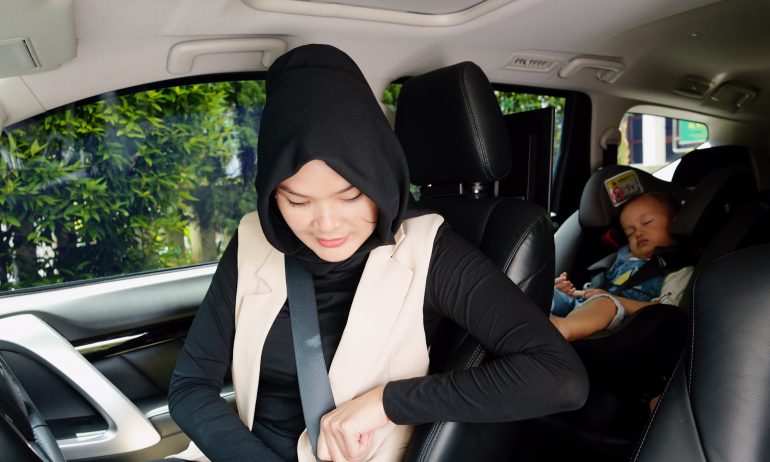Liability Car Insurance: What It Covers and How Much You Need

Many or all of the products featured here are from our partners who compensate us. This influences which products we write about and where and how the product appears on a page. However, this does not influence our evaluations. Our opinions are our own. Here is a list of our partners and here's how we make money.
Liability car insurance pays for other people's expenses if you cause an accident.
It won't pay for your own medical bills or car repairs.
NerdWallet recommends buying enough liability car insurance to cover your net worth.
“Liability” is just another word for responsibility. So, if you’re ever found at-fault after an accident, you’re legally responsible to pay for the damage you cause. And that’s true whether you crash into another car, hit a pedestrian or plow down your neighbor's picket fence. But with liability car insurance, your insurer foots the bill on your behalf, up to your coverage limits.
Unfortunately, liability car insurance is not always cut and dried, and figuring out how much coverage you need can be a challenge. Here’s a closer look at:

What does liability insurance cover?
Liability car insurance covers other people’s expenses when you cause an accident. It has two main components:
Bodily injury liability coverage pays other people’s medical costs when they’re injured in a traffic-related accident you cause. It covers things like medical bills, pain and suffering, lost wages and even funeral costs.
Property damage liability coverage pays for damage to other people's property after a traffic-related accident you cause. This can range from cars and fences to buildings and government infrastructure, like guardrails and road signs. It may even pay for other people’s personal belongings and a rental car for the other driver.
Beyond other people’s injuries and property damage, liability car insurance may also cover your own lawyers’ bills or court fees if you’re sued after an accident.
» MORE: What does car insurance cover?
What liability auto insurance doesn't cover
Auto liability insurance won’t pay for your or your family’s medical bills or repairs to your car — it’s only designed to pay others for the damage you cause behind the wheel.
To cover your own bills, you’ll need to get additional types of insurance, such as personal injury protection or health insurance for your medical expenses as well as collision insurance for repairs to your vehicle.
Liability car insurance vs. full coverage
While having liability car insurance may satisfy your state’s minimum requirements, it won’t pay for your own repair costs after an accident. If you want more financial protection, then you can consider full coverage car insurance.
Full coverage insurance isn't a specific type of policy. It’s a term used to describe a policy that combines liability insurance with comprehensive and collision coverage. The term “full coverage” is used because if you have all three coverage types, then your insurance policy will cover most scenarios, including damage to your own vehicle from an accident you cause. It’ll also cover damage caused by natural disasters or vandalism.
Liability car insurance limits
Liability car insurance pays only up to the maximum amounts, or “limits,” specified in your policy. If damage from an accident exceeds those limits, you'll be responsible for paying for the rest of the claim out of pocket.
Most auto policies have three main liability limits, which are often displayed as three numbers on your policy. For example, you may see something like “25/50/25” on your car insurance declaration page. Here’s how to interpret that:
Bodily injury liability limit per person. The first number is the maximum your insurance will pay for injuries to a single person after an accident. (In the example above, “25” stands for $25,000.)
Bodily injury liability limit per accident. The second number is the maximum your insurance will pay for injuries to everyone you hurt in a single accident — except for you or anyone in your household. The per-accident maximum comes into play if multiple people are injured in an accident. (This is the “50” above, meaning $50,000.)
Property damage liability limit per accident. The final number represents the maximum amount your insurance will pay for total property damage you cause. That includes damage to cars, buildings or anything else that isn’t a person. (The “25” above means $25,000.)
Instead of having three separate limits, some insurers offer an alternative called “combined single limit” liability. Combined single limit liability is one larger liability limit to cover both bodily injury and property damage.
In many cases, the flexibility of this type of liability insurance means more financial protection than split limit coverage. However, combined single limit liability coverage generally costs more than paying for three separate limits.
» MORE: Compare car insurance
How much liability coverage you need
Nearly every state requires at least some liability coverage (or proof you have enough cash on the side to pay for damages yourself). The only exceptions are rural parts of Alaska without requirements and Virginia, where residents can waive liability coverage if they pay the state $500 annually. Here’s a list of all state minimum car insurance requirements.
While many states have low liability limit requirements, you may want a higher limit to protect your savings and other financial assets if you cause an accident. Medical bills and car repairs can be incredibly expensive, and if you’re found at-fault then you’ll be responsible for the balance.
For example, say you hit another car, total it and seriously injure four people. If you’re at fault, you’ll be responsible for the value of the car, the medical bills of all four passengers and any damage to the roadway. Now, you’re looking at paying almost $500,000 in medical bills and another $50,000 for the car and damaged roadway. Do you have enough liability auto insurance to pay for those costs?
If your bodily injury and property damage limits aren’t high enough to cover the full amount, then you could be held personally responsible for anything above your liability limits. The people you injured could sue you for that money, and you could end up losing your home or, in some states, having your wages withheld.
As a general rule, you’ll want enough liability insurance to cover your net worth. That’s equal to the value of all the cash and investments you have plus the things you own, minus your debt. There’s less incentive to sue you if you have a low net worth, so you may not need any additional coverage.
Need more auto liability insurance? Grab an umbrella
Your car insurance company might not offer liability limits high enough to cover your net worth. If you think you’ll need more liability coverage than your auto insurer will provide, consider umbrella insurance. Umbrella policies expand auto and home liability insurance beyond your carrier’s normal limits.
In general, umbrella policies cover those who have a lot of assets or more opportunities to encounter risk. You might have the sort of risk an umbrella policy is meant to cover if you:
Host lots of parties.
Have a swimming pool, trampoline or other feature that could be considered an “attractive nuisance.”
Own one or more dogs. Depending on the breed of your dog, your insurer may not cover your animal.
Own boats, RVs, multiple homes or rental properties.
How much does liability insurance cost?
The national average car insurance cost of minimum car insurance, which typically includes liability auto insurance and other state-mandated coverage, is $549 per year, according to NerdWallet’s January 2024 rate analysis. This rate goes up to $817 per year, on average, if you have an at-fault accident on your record. For drivers who have a recent DWI or DUI, minimum coverage liability insurance costs $1,045, on average.
Car insurance rates vary widely by state and are also influenced by things like your age, your personal driving history, the make and model of car and, in some states, your credit score. However, California, Hawaii and Massachusetts don't allow insurers to use credit when determining car insurance rates.
Other articles about liability insurance |
|---|
NerdWallet has several articles that answer specific questions related to liability insurance: |

NerdWallet averaged rates based on public filings obtained by pricing analytics company Quadrant Information Services. We examined rates for men and women for all ZIP codes in all of the 50 states and Washington, D.C. Although it’s one of the largest insurers in the country, Liberty Mutual is not included in our rates analysis due to a lack of publicly available information.
In our analysis, “good drivers” had no moving violations on record; a “good driving” discount was included for this profile. Our “good” and “poor” credit rates are based on credit score approximations and do not account for proprietary scoring criteria used by insurance providers.
These are median rates, and your rate will vary based on your personal details, state and insurance provider.
Sample drivers had the following coverage limits:
$100,000 bodily injury liability coverage per person.
$300,000 bodily injury liability coverage per crash.
$50,000 property damage liability coverage per crash.
$100,000 uninsured motorist bodily injury coverage per person.
$300,000 uninsured motorist bodily injury coverage per crash.
Collision coverage with $1,000 deductible.
Comprehensive coverage with $1,000 deductible.
In states where required, minimum additional coverages were added. We used the same assumptions for all other driver profiles, with the following exceptions:
For drivers with minimum coverage, we adjusted the numbers above to reflect only the minimum coverage required by law in the state.
We changed the credit tier from “good” to “poor” as reported to the insurer to see rates for drivers with poor credit. In states where credit isn’t taken into account, we only used rates for “good credit.”
For drivers with one at-fault crash, we added a single at-fault crash costing $10,000 in property damage.
For drivers with a DUI, we added a single drunken-driving violation.
For drivers with a ticket, we added a single speeding violation for driving 16 mph over the speed limit.
We used a 2021 Toyota Camry L in all cases and assumed 12,000 annual miles driven. We analyzed rates for drivers of the following ages: 20, 30, 35, 40, 50, 60 and 70.
These are rates generated through Quadrant Information Services. Your own rates will be different.
On a similar note...



